MAZDA MODEL MAZDASPEED 6 2006 Owners Manual (in English)
Manufacturer: MAZDA, Model Year: 2006, Model line: MODEL MAZDASPEED 6, Model: MAZDA MODEL MAZDASPEED 6 2006Pages: 354, PDF Size: 6.5 MB
Page 241 of 354
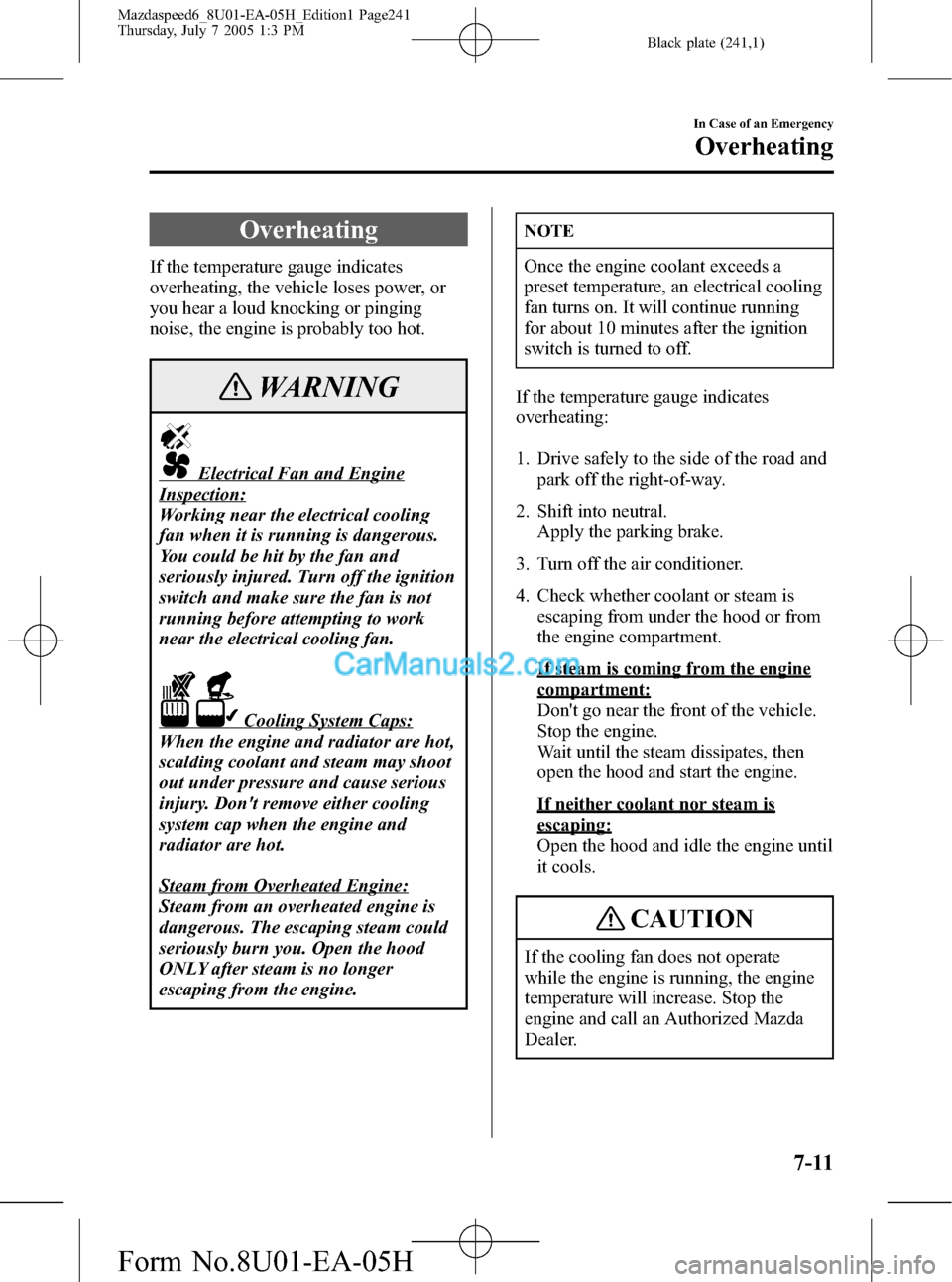
Black plate (241,1)
Overheating
If the temperature gauge indicates
overheating, the vehicle loses power, or
you hear a loud knocking or pinging
noise, the engine is probably too hot.
WARNING
Electrical Fan and Engine
Inspection:
Working near the electrical cooling
fan when it is running is dangerous.
You could be hit by the fan and
seriously injured. Turn off the ignition
switch and make sure the fan is not
running before attempting to work
near the electrical cooling fan.
Cooling System Caps:
When the engine and radiator are hot,
scalding coolant and steam may shoot
out under pressure and cause serious
injury. Don't remove either cooling
system cap when the engine and
radiator are hot.
Steam from Overheated Engine:
Steam from an overheated engine is
dangerous. The escaping steam could
seriously burn you. Open the hood
ONLY after steam is no longer
escaping from the engine.
NOTE
Once the engine coolant exceeds a
preset temperature, an electrical cooling
fan turns on. It will continue running
for about 10 minutes after the ignition
switch is turned to off.
If the temperature gauge indicates
overheating:
1. Drive safely to the side of the road and
park off the right-of-way.
2. Shift into neutral.
Apply the parking brake.
3. Turn off the air conditioner.
4. Check whether coolant or steam is
escaping from under the hood or from
the engine compartment.
If steam is coming from the engine
compartment:
Don't go near the front of the vehicle.
Stop the engine.
Wait until the steam dissipates, then
open the hood and start the engine.
If neither coolant nor steam is
escaping:
Open the hood and idle the engine until
it cools.
CAUTION
If the cooling fan does not operate
while the engine is running, the engine
temperature will increase. Stop the
engine and call an Authorized Mazda
Dealer.
In Case of an Emergency
Overheating
7-11
Mazdaspeed6_8U01-EA-05H_Edition1 Page241
Thursday, July 7 2005 1:3 PM
Form No.8U01-EA-05H
Page 242 of 354
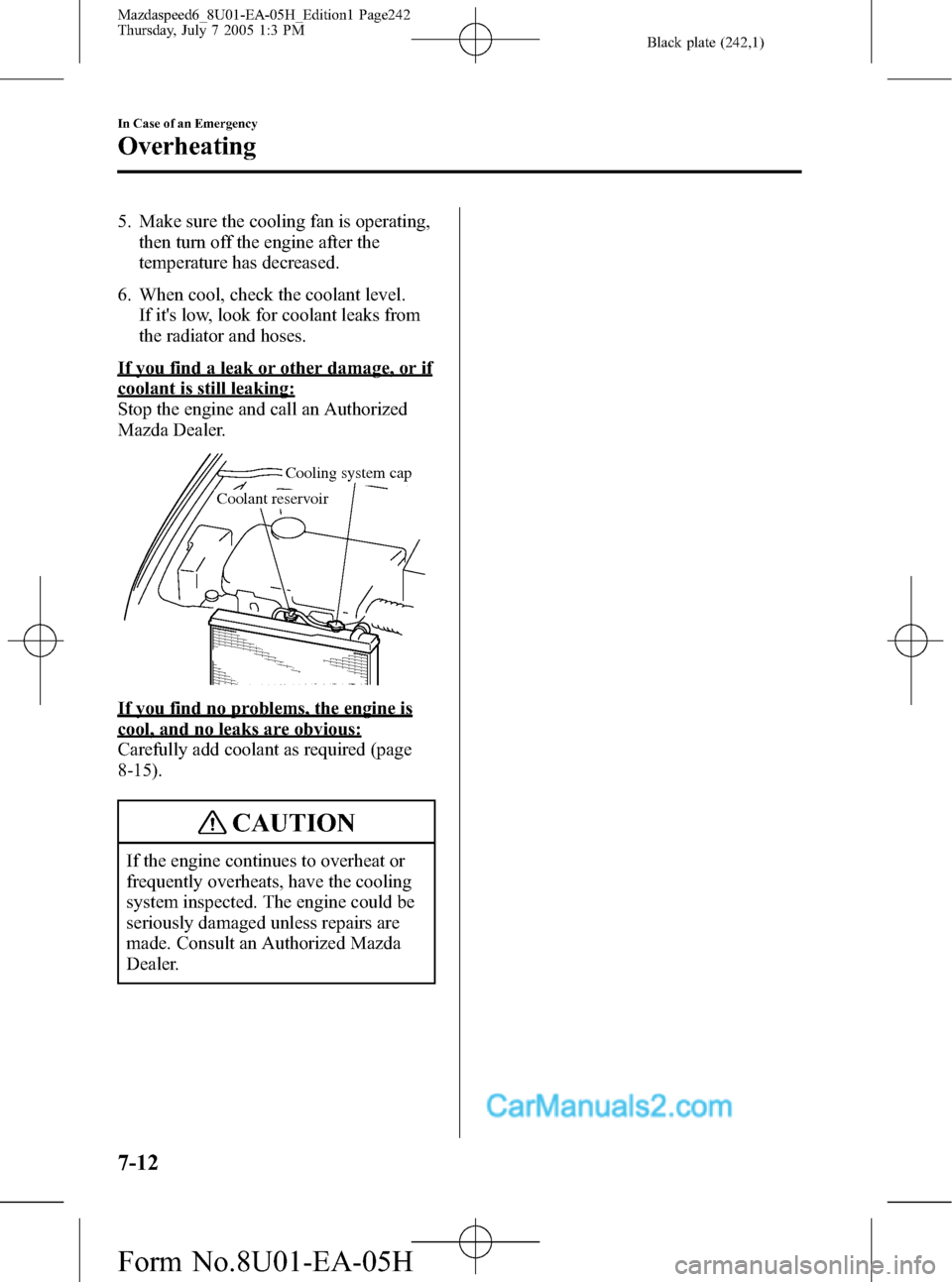
Black plate (242,1)
5. Make sure the cooling fan is operating,
then turn off the engine after the
temperature has decreased.
6. When cool, check the coolant level.
If it's low, look for coolant leaks from
the radiator and hoses.
If you find a leak or other damage, or if
coolant is still leaking:
Stop the engine and call an Authorized
Mazda Dealer.
Coolant reservoir
Cooling system cap
If you find no problems, the engine is
cool, and no leaks are obvious:
Carefully add coolant as required (page
8-15).
CAUTION
If the engine continues to overheat or
frequently overheats, have the cooling
system inspected. The engine could be
seriously damaged unless repairs are
made. Consult an Authorized Mazda
Dealer.
7-12
In Case of an Emergency
Overheating
Mazdaspeed6_8U01-EA-05H_Edition1 Page242
Thursday, July 7 2005 1:3 PM
Form No.8U01-EA-05H
Page 243 of 354

Black plate (243,1)
Starting a Flooded Engine
If the engine fails to start, it may be
flooded (excessive fuel in the engine).
Follow this procedure:
1. Depress the accelerator all the way and
hold it there.
2. Turn the ignition switch to the START
position and hold it there―for up to 10
seconds. If the engine starts, release the
key and accelerator immediately
because the engine will suddenly rev
up.
3. If the engine fails to start, crank it
without depressing the accelerator―for
up to 10 seconds.
In Case of an Emergency
Emergency Starting
7-13
Mazdaspeed6_8U01-EA-05H_Edition1 Page243
Thursday, July 7 2005 1:3 PM
Form No.8U01-EA-05H
Page 244 of 354
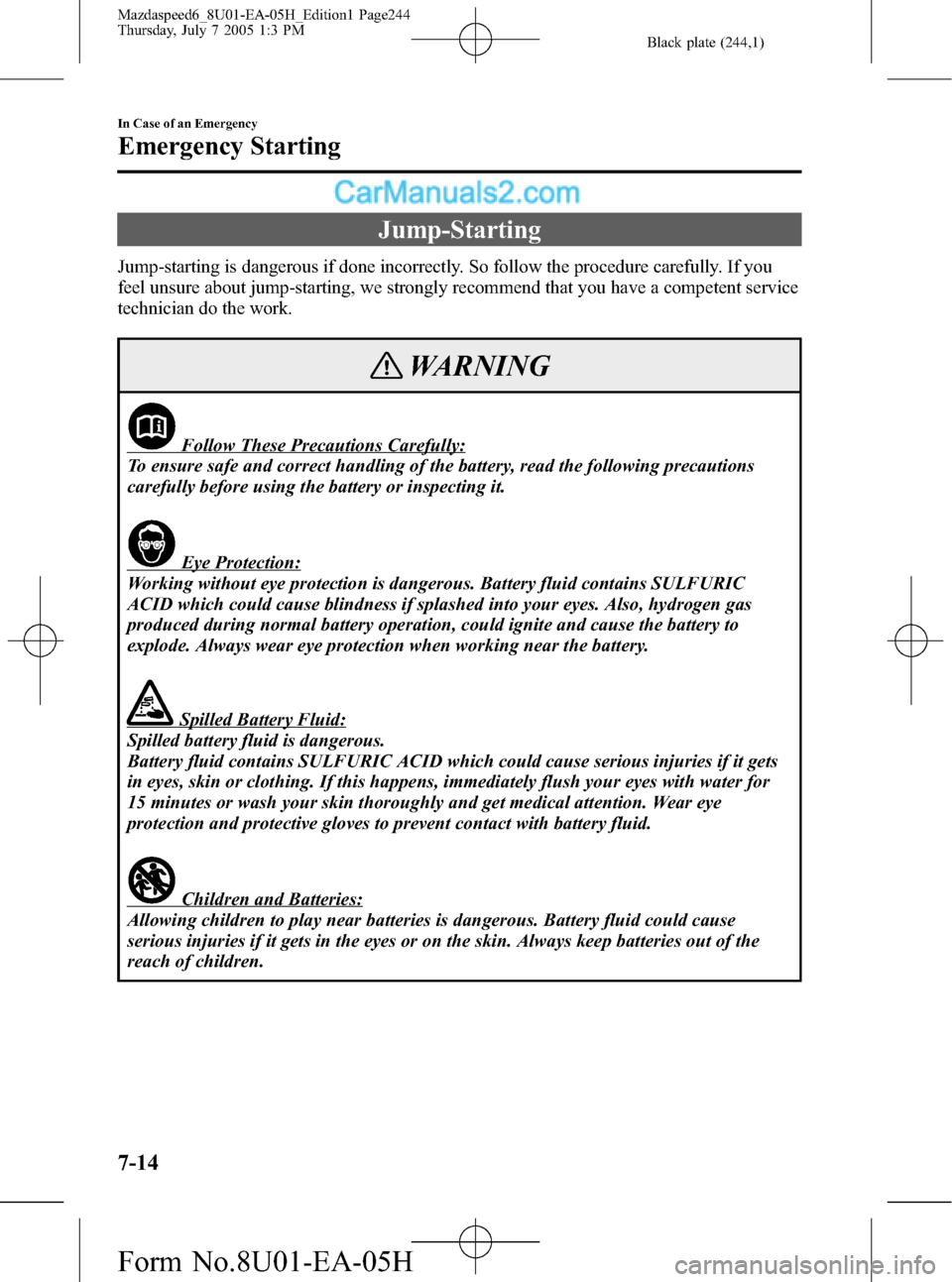
Black plate (244,1)
Jump-Starting
Jump-starting is dangerous if done incorrectly. So follow the procedure carefully. If you
feel unsure about jump-starting, we strongly recommend that you have a competent service
technician do the work.
WARNING
Follow These Precautions Carefully:
To ensure safe and correct handling of the battery, read the following precautions
carefully before using the battery or inspecting it.
Eye Protection:
Working without eye protection is dangerous. Battery fluid contains SULFURIC
ACID which could cause blindness if splashed into your eyes. Also, hydrogen gas
produced during normal battery operation, could ignite and cause the battery to
explode. Always wear eye protection when working near the battery.
Spilled Battery Fluid:
Spilled battery fluid is dangerous.
Battery fluid contains SULFURIC ACID which could cause serious injuries if it gets
in eyes, skin or clothing. If this happens, immediately flush your eyes with water for
15 minutes or wash your skin thoroughly and get medical attention. Wear eye
protection and protective gloves to prevent contact with battery fluid.
Children and Batteries:
Allowing children to play near batteries is dangerous. Battery fluid could cause
serious injuries if it gets in the eyes or on the skin. Always keep batteries out of the
reach of children.
7-14
In Case of an Emergency
Emergency Starting
Mazdaspeed6_8U01-EA-05H_Edition1 Page244
Thursday, July 7 2005 1:3 PM
Form No.8U01-EA-05H
Page 245 of 354

Black plate (245,1)
WARNING
Keep Flames Away:
Flames and sparks near open battery cells are dangerous. Hydrogen gas, produced
during normal battery operation, could ignite and cause the battery to explode. An
exploding battery can cause serious burns and injuries. Keep all flames including
cigarettes and sparks away from open battery cells. When working near a battery, do
not allow metal tools to contact the positive (
) or negative () terminal of the
battery. Do not allow the positive (
) terminal to contact any other metal object that
could cause sparks.
Battery-Related Explosion:
Flames and sparks near open battery cells are dangerous. Hydrogen gas, produced
during normal battery operation, could ignite and cause the battery to explode. An
exploding battery can cause serious burns and injuries. Keep all flames, including
cigarettes, and sparks away from open battery cells.
Low Fluid Level or Frozen Battery:
Jump-starting a frozen battery or one with a low fluid level is dangerous. It may
rupture or explode, causing serious injury.
Don't jump-start a frozen battery or one with a low fluid level.
Connecting Jumper Cable Directly to Negative Terminal:
Connecting the end of the second jumper cable to the negative (
) terminal of the
discharged battery is dangerous.
A spark could cause the gas around the battery to explode and injure someone.
Connect the negative cable to a good ground point away from the battery.
Connecting Jumper Cable to Moving Parts:
Connecting a jumper cable near or to moving parts (cooling fans, belts) is dangerous.
The cable could get caught when the engine starts and cause serious injury. Route the
jumper cables away from parts that will be moving.
CAUTION
Use only a 12 V booster system. You can damage a 12 V starter, ignition system, and
other electrical parts beyond repair with a 24 V power supply (two 12 V batteries in
series or a 24 V motor generator set).
In Case of an Emergency
Emergency Starting
7-15
Mazdaspeed6_8U01-EA-05H_Edition1 Page245
Thursday, July 7 2005 1:3 PM
Form No.8U01-EA-05H
Page 246 of 354

Black plate (246,1)
Booster battery Jumper cables
Connect cables in numerical order and disconnect in reverse order.
Discharged
battery
1. Make sure the booster battery is 12 V
and that its negative terminal is
grounded.
2. If the booster battery is in another
vehicle, don't allow both vehicles to
touch. Turn off the engine of the
vehicle with the booster battery and all
unnecessary electrical loads in both
vehicles.
3. Connect the jumper cables in the exact
sequence as in the illustration.
lConnect one end of a cable to the
positive terminal on the discharged
battery (1).
lAttach the other end to the positive
terminal on the booster battery (2).
lConnect one end of the other cable
to the negative terminal of the
booster battery (3).
lConnect the other end to a solid,
stationary, exposed metallic point
(for example, the strut mounting
bolt) away from the discharged
battery (4).4. Start the engine of the booster vehicle
and run it a few minutes. Then start the
engine of the other vehicle.
5. When finished, carefully disconnect the
cables in the reverse order described in
the illustration.
7-16
In Case of an Emergency
Emergency Starting
Mazdaspeed6_8U01-EA-05H_Edition1 Page246
Thursday, July 7 2005 1:4 PM
Form No.8U01-EA-05H
Page 247 of 354

Black plate (247,1)
Push-Starting
WARNING
Towing a Vehicle to Start It:
Towing a vehicle to start it is
dangerous. The vehicle being towed
could surge forward when its engine
starts, causing the two vehicles to
collide. The occupants could be
injured. Never tow a vehicle to start it.
CAUTION
Do not push-start a vehicle that has a
manual transaxle. It can damage the
emission control system.
In Case of an Emergency
Emergency Starting
7-17
Mazdaspeed6_8U01-EA-05H_Edition1 Page247
Thursday, July 7 2005 1:4 PM
Form No.8U01-EA-05H
Page 248 of 354
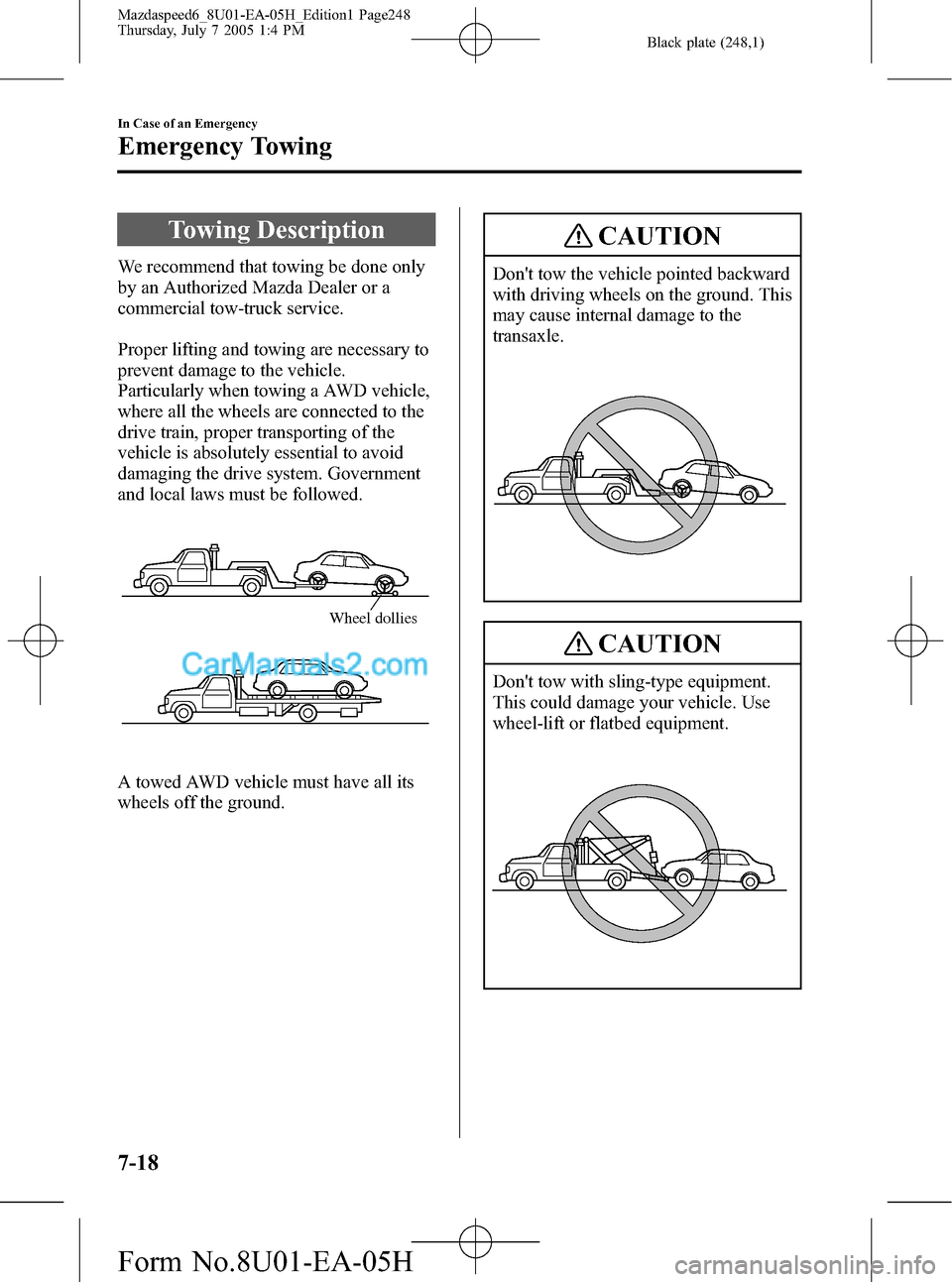
Black plate (248,1)
Towing Description
We recommend that towing be done only
by an Authorized Mazda Dealer or a
commercial tow-truck service.
Proper lifting and towing are necessary to
prevent damage to the vehicle.
Particularly when towing a AWD vehicle,
where all the wheels are connected to the
drive train, proper transporting of the
vehicle is absolutely essential to avoid
damaging the drive system. Government
and local laws must be followed.
Wheel dollies
A towed AWD vehicle must have all its
wheels off the ground.
CAUTION
Don't tow the vehicle pointed backward
with driving wheels on the ground. This
may cause internal damage to the
transaxle.
CAUTION
Don't tow with sling-type equipment.
This could damage your vehicle. Use
wheel-lift or flatbed equipment.
7-18
In Case of an Emergency
Emergency Towing
Mazdaspeed6_8U01-EA-05H_Edition1 Page248
Thursday, July 7 2005 1:4 PM
Form No.8U01-EA-05H
Page 249 of 354
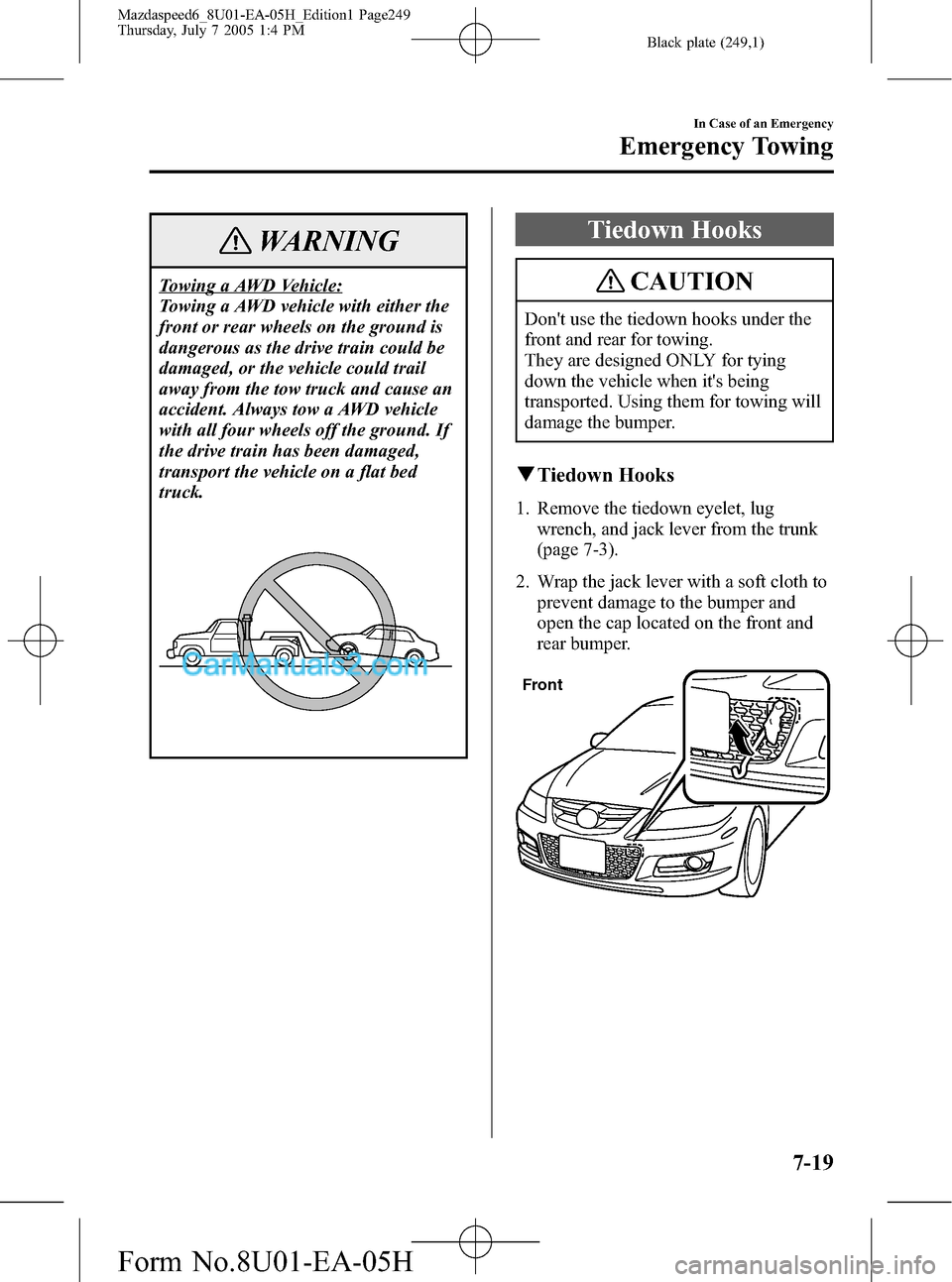
Black plate (249,1)
WARNING
Towing a AWD Vehicle:
Towing a AWD vehicle with either the
front or rear wheels on the ground is
dangerous as the drive train could be
damaged, or the vehicle could trail
away from the tow truck and cause an
accident. Always tow a AWD vehicle
with all four wheels off the ground. If
the drive train has been damaged,
transport the vehicle on a flat bed
truck.
Tiedown Hooks
CAUTION
Don't use the tiedown hooks under the
front and rear for towing.
They are designed ONLY for tying
down the vehicle when it's being
transported. Using them for towing will
damage the bumper.
qTiedown Hooks
1. Remove the tiedown eyelet, lug
wrench, and jack lever from the trunk
(page 7-3).
2. Wrap the jack lever with a soft cloth to
prevent damage to the bumper and
open the cap located on the front and
rear bumper.
Front
In Case of an Emergency
Emergency Towing
7-19
Mazdaspeed6_8U01-EA-05H_Edition1 Page249
Thursday, July 7 2005 1:4 PM
Form No.8U01-EA-05H
Page 250 of 354

Black plate (250,1)
Rear
CAUTION
The cap cannot be completely removed.
Do not use excessive force as it may
damage the cap or scratch the painted
bumper surface.
3. Securely install the tiedown eyelet
using the lug wrench.
Front
Lug wrench
RearLug wrench
4. Hook the tying rope to the tiedown
eyelet.
Front
Rear
7-20
In Case of an Emergency
Emergency Towing
Mazdaspeed6_8U01-EA-05H_Edition1 Page250
Thursday, July 7 2005 1:4 PM
Form No.8U01-EA-05H